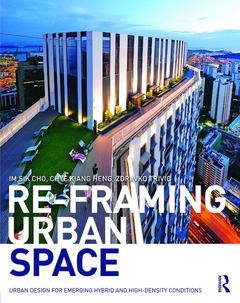Description
Re-Framing Urban Space
Urban Design for Emerging Hybrid and High-Density Conditions
Authors: Cho Im Sik, Heng Chye-Kiang, Trivic Zdravko
Language: English
Subject for Re-Framing Urban Space:
Keywords
public space; Jan Gehl; hybrid typologies; urban space; high-density; urban development; design principles; high-rise development; Clarke Quay; Monolith Hybrid; High Line Park; Hybrid Urban Space; High Context Density; High Density Conditions; Urban Space Performance; Roppongi Hills; General Healthcare Service; H2 Scale; Bryant Park; Urban Space Quality; Universal Access; Seating Amenities; Public Art; Multi-level Network; Informal Seating; Key Urban Space; Pedestrian Network; Circular Chart; GFA; Design Measures; York City Department
Approximative price 101.34 €
In Print (Delivery period: 14 days).
Add to cartPublication date: 10-2015
Support: Print on demand
Approximative price 271.33 €
In Print (Delivery period: 14 days).
Add to cartPublication date: 11-2015
· 21.9x27.6 cm · Hardback
Description
/li>Contents
/li>Readership
/li>Biography
/li>
Re-framing Urban Space: Urban Design for Emerging Hybrid and High-Density Conditions rethinks the role and meaning of urban spaces through current trends and challenges in urban development. In emerging dense, hybrid, complex and dynamic urban conditions, public urban space is not only a precious and contested commodity, but also one of the key vehicles for achieving socially, environmentally and economically sustainable urban living. Past research has been predominantly focused on familiar models of urban space, such as squares, plazas, streets, parks and arcades, without consistent and clear rules on what constitutes good urban space, let alone what constitutes good urban space in ?high-density context?.
Through an innovative and integrative research framework, Re-Framing Urban Space guides the assessment, planning, design and re-design of urban spaces at various stages of the decision-making process, facilitating an understanding of how enduring qualities are expressed and negotiated through design measures in high-density urban environments. This book explores over 50 best practice case studies of recent urban design projects in high-density contexts, including Singapore, Beijing, Tokyo, New York, and Rotterdam.
Visually compelling and insightful, Re-Framing Urban Space provides a comprehensive and accessible means to understand the critical properties that shape new urban spaces, illustrating key design components and principles. An invaluable guide to the stages of urban design, planning, policy and decision making, this bookis essential reading for urban design and planning professionals, academics and students interested in public spaces within high-density urban development.
1. Review – Urban Space & Current Tendencies in Urban Development 2. Understanding - Quality of Urban Space and Design Principles 3. Assessment & Analysis – Assessing the Quality of Urban Space 4. Application – Guide to Design Actions 5. Epilogue
Im Sik Cho is an assistant professor at the Department of Architecture, School of Design and Environment, National University of Singapore, where she serves as the leader for urban studies research and teaching and principal investigator for many research projects related to urban space design and participatory planning for sustainable high-density environment.
Chye Kiang Heng is a professor, urban designer and planner. Currently, he is the dean of the School of Design and Environment at the National University of Singapore. He has published four books and numerous articles and book chapters. He is visiting professor at several leading Asian universities and serves on the editorial board of a number of international journals.
Zdravko Trivic is an assistant professor at the Department of Architecture, School of Design and Environment (SDE), National University of Singapore (NUS). He also worked as a researcher at the Centre for Sustainable Cities (CSAC), SDE, NUS. His research and design work in the areas of urban design and health and space theories has been presented internationally. He has published several book chapters and conference and journal articles.




